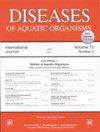在畸形日本鳗鲡(Anguilla japonica lepptocephali)脊索鞘周围发现新的组织增厚
IF 1.1
4区 农林科学
Q3 FISHERIES
引用次数: 0
摘要
本文章由计算机程序翻译,如有差异,请以英文原文为准。
Novel tissue thickening around the notochord sheath found in deformed Japanese eels Anguilla japonica leptocephali
Even though reared leptocephalus larvae of the Japanese eel Anguilla japonica have a high incidence of notochord deformities (>60%), the cause is unknown. We performed histological examinations of the notochord and associated organs in reared larvae to better understand the process causing notochord deformation in eel larvae. In deformed larvae, unknown tissue thickening was discovered near the notochord sheath. Azan staining revealed that these tissue thickenings are most likely collagen fibers within fibrous connective tissue. This was almost identical to the connective tissue found in the primordium of the vertebral body around the notochord sheath in properly metamorphosing larvae. Furthermore, the amount of the thyroid hormone triiodothyronine (T3) was significantly higher in deformed larvae than in normal larvae, indicating that notochord deformity is probably linked to metamorphosis despite the immature stage of growth. We suggest that the aberrant growth of connective tissue surrounding the notochord sheath induced by incomplete metamorphosis causes deformities in eel larvae. The reason why deformed larvae have greater thyroid hormone levels is still unknown. It is important to assess how environmental and dietary factors affect the thyroid hormone levels of eel larvae raised in captivity.
求助全文
通过发布文献求助,成功后即可免费获取论文全文。
去求助
来源期刊

Diseases of aquatic organisms
农林科学-兽医学
CiteScore
3.10
自引率
0.00%
发文量
53
审稿时长
8-16 weeks
期刊介绍:
DAO publishes Research Articles, Reviews, and Notes, as well as Comments/Reply Comments (for details see DAO 48:161), Theme Sections and Opinion Pieces. For details consult the Guidelines for Authors. Papers may cover all forms of life - animals, plants and microorganisms - in marine, limnetic and brackish habitats. DAO''s scope includes any research focusing on diseases in aquatic organisms, specifically:
-Diseases caused by coexisting organisms, e.g. viruses, bacteria, fungi, protistans, metazoans; characterization of pathogens
-Diseases caused by abiotic factors (critical intensities of environmental properties, including pollution)-
Diseases due to internal circumstances (innate, idiopathic, genetic)-
Diseases due to proliferative disorders (neoplasms)-
Disease diagnosis, treatment and prevention-
Molecular aspects of diseases-
Nutritional disorders-
Stress and physical injuries-
Epidemiology/epizootiology-
Parasitology-
Toxicology-
Diseases of aquatic organisms affecting human health and well-being (with the focus on the aquatic organism)-
Diseases as indicators of humanity''s detrimental impact on nature-
Genomics, proteomics and metabolomics of disease-
Immunology and disease prevention-
Animal welfare-
Zoonosis
 求助内容:
求助内容: 应助结果提醒方式:
应助结果提醒方式:


